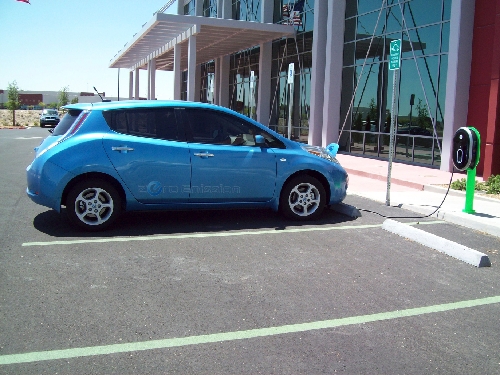Project tracks electric car usage
Idaho National Laboratory has launched the EV Project, an ambitious effort to track the use of plug-in electric cars and the electric vehicle supply equipment that refuels each vehicle's battery pack.
During October 2009, INL began its research in Washington state, Oregon, California, Arizona, Texas, Tennessee, as well as Washington, D.C. Besides collecting and analyzing data to characterize electric vehicle and infrastructure use, the project also aimed to demonstrate measures that would minimize the impacts of vehicle charging on the electric utility grid, and to conduct trials of payment systems and business models that could ignite the growth of the electric vehicle supply equipment industry.
ECOtality, manufacturer of the Blink product line of electric vehicle supply equipment, has partnered with Idaho National Laboratory. The private company received a $99.8 million grant from the U.S. Department of Energy to provide its equipment at no cost to electric car owners and public vending site operators who were willing to participate in the study.
ECOtality equipped its EVSE to send information over a secure wireless network so that the company can continually monitor each unit's usage and operational status at installed sites.
Coulomb Technologies, manufacturer of a competing product line that is monitored by that company's ChargePoint network, also sent data to the EV Project from participating owners of its equipment.
In all, 6,194 charging sites were monitored. Of this total, 4,606 were installed at residential sites while 1,588 were installed at nonresidential sites.
The collected data showed that when electric vehicles were charged at home sites, mostly at night, their battery packs were recharged to more than 90 percent capacity about 65 percent of the time. However, when on the road using public charging stations during the day, an electric car's battery pack was recharged above 90 percent capacity just 40 percent of the time, and recharged between 70 percent to 80 percent capacity about 20 percent of the time.
Electronic data loggers also were installed in participating electric cars within the project to continuously receive streams of information for analysis by INL. More than half of the electric vehicle data for the automotive industry was gathered from 4,191 Nissan Leafs and 428 Chevy Volts. These electric vehicles were driven a combined 27.6 million miles through all types of weather and terrain within the seven participating regions of the country. On an average day, the project gathered road data from 104,000 miles traveled and 3,615 recharging events.
Analysis of the data showed that the Nissan Leaf battery-powered electric vehicles were driven, on average, 30 miles per day, while the extended-range electric Chevy Volts were driven about 36 miles per day. Each of these vehicles were plugged in more than once per day to recharge their battery packs before traveling about 27 miles in the Leaf and about 24 miles in the Volt between plug-ins.
Though Nevada is not part of the study, our state started adopting electric vehicles and infrastructure on a larger scale this year. There are now 16 automotive dealerships throughout Nevada selling plug-in electric cars like the GM Chevrolet Volt, Nissan Leaf, Fisker Karma and Mitsubishi i-series.
Although many electric-car buyers choose to recharge their vehicles at home, public infrastructure is growing in more populated areas in Nevada. Most dealerships that sell electric cars also offer free electric fuel through public stations on their sales lots, becoming part of their manufacturers' cross-country network of recharging sites. Some dealerships even allow competing manufacturers' vehicles to use their sites, as long as they comply with the standard connector ports agreed upon by the automotive industry in 2009.
Public charging stations in Nevada also can be found at hotel-casinos, private companies, NV Energy electric utility offices, and at county and city government offices. There are now about 33 public sites statewide that supply about 65 high-power charging plugs to refuel an electric car in about four to six hours.
To find these sites, and the type of EVSE connectors provided, electric car owners just need to browse their dashboard GPS navigation system where they can also determine whether the site is being used by another electric car or not. There are also applications available for Apple and Android mobile phones to find sites by ZIP code, city or state. Helpful websites with this information include Plugshare.com, ReCarGo.com, ChargePoint.net, BlinkNetwork.com and the DOE Alternative Fuels Data Center.
For more about the lessons learned from the EV Project, visit the research group website at www.theevproject.com.
Stan Hanel has worked in the electronics industry for more than 30 years and is a long-time member of the Electric Auto Association and the Las Vegas Electric Vehicle Association. Hanel writes and edits for EAA's "Current Events" and LVEVA's "Watts Happening" newsletters. Contact him at stanhanel@aol.com.














